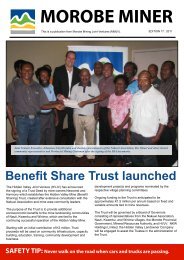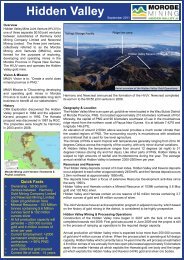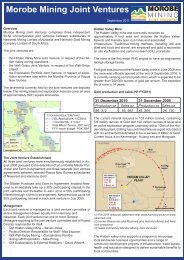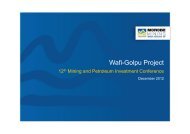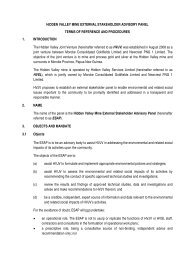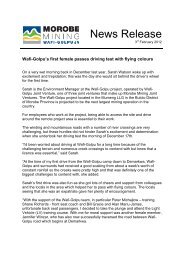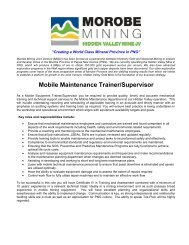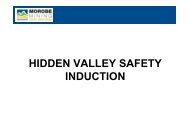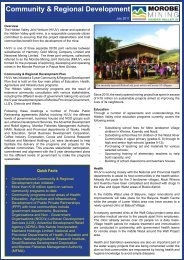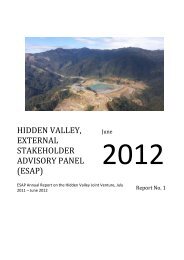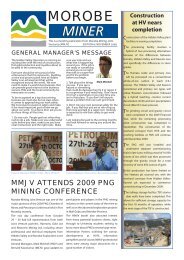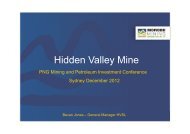MMJV Response to 2012 ESAP Report - Morobe Mining Joint Venture
MMJV Response to 2012 ESAP Report - Morobe Mining Joint Venture
MMJV Response to 2012 ESAP Report - Morobe Mining Joint Venture
Create successful ePaper yourself
Turn your PDF publications into a flip-book with our unique Google optimized e-Paper software.
28 May 2013<br />
Sir Joe Tauvasa<br />
Chairman<br />
Hidden Valley External Stakeholder Advisory Panel<br />
c/- Teisaki Limited<br />
PO Box 725<br />
Port Moresby 121<br />
National Capital District<br />
Dear Sir Joe,<br />
Subject: Comments in Relation <strong>to</strong> Hidden Valley <strong>ESAP</strong> Annual <strong>Report</strong> #1<br />
1. Introduction<br />
The Hidden Valley <strong>Joint</strong> <strong>Venture</strong> (HVJV) welcomes the publication of the first External<br />
Stakeholder Advisory Panel (<strong>ESAP</strong>) report and thanks both you as Chair and the individual<br />
members of <strong>ESAP</strong> for your considered thought and recommendations.<br />
As you note <strong>ESAP</strong> was set up as an independent advisory body <strong>to</strong> the HVJV <strong>to</strong> provide<br />
independent advice in relation <strong>to</strong> the environmental and related social impact of its activities<br />
on its host communities.<br />
I think that both the HVJV and <strong>ESAP</strong> recognise that they are on a journey in first taking the<br />
bold step <strong>to</strong> establish such an advisory body and secondly <strong>to</strong> publish its advice and<br />
recommendations.<br />
You have set out in your report the things you believe we are doing well (especially in terms<br />
of the community benefits and development opportunities that the HVJV is providing). You<br />
have also set out your constructive criticisms and advice on areas for improvement.<br />
We have taken your advice on board.<br />
Since the report was written there have been developments that we should note and there<br />
are some things where we take a different view and need <strong>to</strong> put this on the record in a spirit<br />
of good faith and constructive engagement. We <strong>to</strong>uch on the most significant of these<br />
below.<br />
Before doing that I should say that on the community front we’ve increased our outreach<br />
activities with respect <strong>to</strong> water supply projects, community infrastructure, community health,<br />
and agriculture programs. These programs have assisted greatly in building bridges with<br />
local communities. With the water supply projects we have empowered and contracted<br />
community groups, including the Union of Watut River Communities, <strong>to</strong> construct these<br />
projects in their own communities on our behalf.<br />
In addition <strong>to</strong> the wide-ranging project delivery highlighted above, improved community<br />
consultation is also a key feature of our broader outreach activities. In the most recent<br />
HIDDEN VALLEY SERVICES LIMITED<br />
All correspondence <strong>to</strong>: PO Box 4015, Lae, <strong>Morobe</strong> Province, Papua New Guinea<br />
T: +675 472 1703 F: +675 472 1705 W: www.morobejv.com
28 May 2013<br />
HVJV-Government Watut River Patrol (Oc<strong>to</strong>ber <strong>2012</strong>), the teams provided extensive<br />
information during the community consultations and it was very evident the communities<br />
appreciated the information.<br />
The program of mine visits by community leaders prior <strong>to</strong> the patrol greatly aided the<br />
understanding and posters and other informational material used by the patrol teams are<br />
updated annually as new data becomes available.<br />
2. Managing sediment and its impacts<br />
(a)<br />
Sediment generally<br />
HVJV has acknowledged the increased sediment load in the Upper Watut River<br />
during the period of construction activities of the mine in 2007- 2009. Some<br />
estimates put the <strong>to</strong>tal sediment load during this period at around 30Mt. Importantly<br />
however, there has been substantial and measured improvement in the sediment<br />
concentrations in the river, such that it is now approaching 2006 levels (preconstruction).<br />
Furthermore, as recognised in the <strong>ESAP</strong> report there is a significant contribution of<br />
sediment in the Watut River by various sources over time (in addition <strong>to</strong> any minederived<br />
sediments) – being, the Bulolo River, Kumalu/Snake Rivers and others.<br />
While it will always be difficult <strong>to</strong> precisely estimate relative contributions, this does<br />
provide a picture for the whole of the river system and its multiple sources of high<br />
sediment load inputs <strong>to</strong> the broader Watut River system. A thorough understanding<br />
of the fate of mine-derived sediment has been a key focus. However, it is important<br />
<strong>to</strong> note that the moni<strong>to</strong>ring of metals concentrations in the river system, a significant<br />
element of our continuous moni<strong>to</strong>ring program, continue <strong>to</strong> indicate that metal levels<br />
do not appear <strong>to</strong> have increased when compared <strong>to</strong> pre-mining baseline studies.<br />
On the subject of the res<strong>to</strong>ration of the entire river system this <strong>to</strong>o is something the<br />
HVJV would like <strong>to</strong> work with others on but does not believe that it alone should<br />
shoulder the burden of “res<strong>to</strong>ring the river system”. The mine will continue <strong>to</strong><br />
address the management of potential mine-derived sedimentation in the upper Watut<br />
but all stakeholders need <strong>to</strong> acknowledge that below the Bulolo River junction there<br />
are other significant sources of sediment which are beyond our control. <strong>ESAP</strong> and<br />
others recognize that there are many sources of the sediment in the Watut River<br />
system and HVJV looks forward <strong>to</strong> working with other stakeholders <strong>to</strong> address issues<br />
associated with the river.<br />
We also appreciate the effort that <strong>ESAP</strong> is putting in<strong>to</strong> the process of the<br />
development a river health scorecard <strong>to</strong> assist with stakeholder communications.<br />
As consistently noted in this letter and in the <strong>ESAP</strong> report, the Hidden Valley mine is<br />
not the only contribu<strong>to</strong>r of sediment <strong>to</strong> the Watut River system and the combined or<br />
<strong>to</strong>tal sediment load <strong>to</strong> the system varies spatially (from the various sources and<br />
tributaries) and over time between these different sources. Estimating when the<br />
upper Watut (the only area over which we have some control) will recover can only<br />
be assessed on the basis of the complex interrelationships between the key drivers<br />
(sediment load and sediment transport, hydrology, and metals loads) with the key<br />
response components (river morphology and biologic responses) over time. We will<br />
continue <strong>to</strong> assess what changes occur in flora/fauna abundance and species<br />
diversity over time. To predict when the river will recover is a very difficult thing <strong>to</strong><br />
Page 2 of 8
28 May 2013<br />
determine at this early-stage and we are seeking collaborative partners <strong>to</strong> assist with<br />
this work.<br />
(b)<br />
Waste rock dumps<br />
We recognise that there were challenges during the mine construction period with<br />
construction of waste rock dumps. Since this time the mine has continued <strong>to</strong> build<br />
and seek best available materials for waste dumps. The mine has also progressively<br />
rehabilitated cleared areas and established sediment traps in the mine which have all<br />
contributed <strong>to</strong> significant improvement in the management of mine-derived sediment<br />
risks. We continue <strong>to</strong> explore ways <strong>to</strong> further improve the construction of waste<br />
dumps and dams.<br />
(c)<br />
Dieback<br />
With respect <strong>to</strong> impacts on the flood plain and dieback, it is not clear whether or not<br />
the dieback can be fully attributed <strong>to</strong> the mine. The majority of the acute dieback,<br />
which contributed <strong>to</strong> 80% of the <strong>to</strong>tal area of dieback (just over 400 ha) has<br />
recovered. The dieback process was explained <strong>to</strong> the communities during community<br />
consultations and, in recognition that mine-derived sediment may have contributed <strong>to</strong><br />
increased sediment load in the river in response <strong>to</strong> the cumulative amounts of natural<br />
and mine-derived sediments. In 2010 - <strong>2012</strong> HVJV voluntarily paid compensation <strong>to</strong><br />
landowners along the Watut River whose crops and gardens were effected by<br />
dieback. As highlighted in the report, it is difficult <strong>to</strong> attribute "blame" with respect <strong>to</strong><br />
dieback and that there is no "easy" way <strong>to</strong> tell the s<strong>to</strong>ry given that the sediment<br />
contributing <strong>to</strong> the dieback has come from many sources. The environmental<br />
scorecard which <strong>ESAP</strong> is producing should be helpful in communicating this concept.<br />
(d)<br />
Fish and aquatic ecology<br />
While the report suggests that that sediment from the mine has contributed <strong>to</strong> a<br />
major decline in fish populations, we firmly believe this statement only <strong>to</strong> be true for<br />
the upper reaches of the Watut River. Other areas of the river system are impacted<br />
by other major contribu<strong>to</strong>rs <strong>to</strong> the sediment load as discussed throughout your report.<br />
With respect <strong>to</strong> aquatic ecology, we have continuous moni<strong>to</strong>ring of the macro benthic<br />
invertebrate studies (plus the dia<strong>to</strong>ms). Currently sample numbers are <strong>to</strong>o low <strong>to</strong><br />
draw valid statistical comparisons with respect <strong>to</strong> bioaccumulation in fish and prawn<br />
tissues. HVJV is continuing work <strong>to</strong> improve our fish and prawn sampling program.<br />
3. Managing ARD and water quality<br />
We acknowledge that the management of potential Acid Rock Drainage (ARD) from the<br />
waste rock dumps both during mine life and beyond is an important area of continuing focus<br />
at the site. An ARD mitigation strategy has been developed in the past and is currently<br />
being reviewed in an effort <strong>to</strong> ensure appropriate management based on current available<br />
knowledge.<br />
Based on moni<strong>to</strong>ring programs <strong>to</strong>-date, there is no evidence suggesting that ARD may be<br />
occurring within the river system. This is consistent with the low level of Potentially Acid<br />
Forming material identified in deposited sediment throughout the river system <strong>to</strong>-date.<br />
Nevertheless, ARD management will remain a focus.<br />
Page 3 of 8
28 May 2013<br />
Compliance levels – we do acknowledge there are some differences and we take on board<br />
<strong>ESAP</strong>s comments. It is important <strong>to</strong> note that HVJV strives <strong>to</strong> comply with its internal criteria<br />
which are actually more stringent than is currently required by the mine’s discharge permit.<br />
For example DEC’s revised limit for Cu is 100ppb while HVJV has an internal limit of 6.5ppb.<br />
4. Baseline information<br />
We recognise, with the benefit of hindsight, there are ways in which the scope of baseline<br />
assessments undertaken prior <strong>to</strong> construction of the mine could have been improved. This<br />
should not take away from the fact that detailed baseline studies covering environmental,<br />
cultural heritage, social and health issues were undertaken as part of a formal EIS in<br />
accordance with PNG legal requirements.<br />
To improve our understanding of conditions, assist with our continuing management of the<br />
potential impact of the mine and <strong>to</strong> inform ongoing programs <strong>to</strong> support the community, in<br />
Oc<strong>to</strong>ber/November <strong>2012</strong> we under<strong>to</strong>ok follow up health and biomedical study work covering<br />
communities along the entire length of the Watut River system. This report will be made<br />
available <strong>to</strong> government, communities and <strong>ESAP</strong> once completed and will be used as the<br />
basis <strong>to</strong> support community health programs going forward.<br />
5. Community engagement and contributions<br />
(a)<br />
(b)<br />
Our wider community development programme<br />
With respect <strong>to</strong> comment on the broad social and community areas of empowerment,<br />
future generation funds and landowner relations, <strong>ESAP</strong> may not have been aware of<br />
all of the work being done in this area as much of it sits outside <strong>ESAP</strong>’s overall<br />
mandate. Programs including: business development, capacity building, small scale<br />
miner training, agriculture and aquaculture, health, education and community<br />
infrastructure, descriptions of which can be found on the <strong>MMJV</strong> website. Many of<br />
these programs we have run in partnership with others and those where we’ve not<br />
had partners we are actively seeking them.<br />
The MOA review<br />
The HV MOA review which commenced in June <strong>2012</strong> is an inclusive process and<br />
has as its core goals:<br />
<br />
<br />
the establishment of a framework within which Hidden Valley <strong>Joint</strong> <strong>Venture</strong>,<br />
the landowning communities and other stakeholders can successfully discuss<br />
issues of mutual interest relating <strong>to</strong> the MOA, and<br />
<strong>to</strong> effectively agree on an appropriate balance between the mine’s social and<br />
economic benefits, and the environmental impacts.<br />
While the scope of the review is largely established through the existing MOA and its<br />
component parts, it is HVJV’s view that the scope should not be limited <strong>to</strong> what is<br />
within the current MOA, providing it falls within the concept of achieving an<br />
“appropriate balance between the mine’s social and economic benefits, and the<br />
environmental impacts”.<br />
Page 4 of 8
28 May 2013<br />
With respect <strong>to</strong> the comments regarding distribution of royalties raised by women and<br />
youth at Nauti Village (downstream of the mine), representations have been raised<br />
by them through the Nauti position paper which was tabled at the Hidden Valley MOA<br />
review meeting. These issues will be addressed by that forum.<br />
(c)<br />
Social and Community generally<br />
Our main point here is that the primary responsibility for social issues including:<br />
• Empowerment of the community and people;<br />
• Welfare for future generations; and<br />
• Ongoing landowner issues management<br />
must rest with communities themselves and with the Government. HVJV can<br />
incorporate these in<strong>to</strong> core elements of our Social Responsibility Policy and in each<br />
and every program and project that we undertake but we cannot and should not<br />
assume this accountability.<br />
More work does need <strong>to</strong> be done in this area however and we’ve made a start with<br />
the formation of the Village Planning Committees in the mine communities for the<br />
Benefit Sharing Trust (BST). This is the first time that the mine communities have<br />
been directly involved in the decision making process with respect <strong>to</strong> benefits as<br />
previously everything has gone through the Nakuwi Association – the mining area<br />
landowner association.<br />
In addition <strong>to</strong> the mine villages, we are reaching out <strong>to</strong> widen our engagement with<br />
the Union of Watut River Communities, a group that has been very antagonistic <strong>to</strong><br />
the Hidden Valley operations and its real/perceived impact on the Watut River, <strong>to</strong><br />
take a leading role in the identification and implementation of an initial set of<br />
community development projects in middle Watut communities. If we can establish<br />
this process with the Union then there’s no reason we can’t look at engaging other<br />
community groups.<br />
Financial literacy and Personal Viability training have been flagged in the Benefit<br />
Streams Analysis report that was undertaken Mike Finlayson, a consultant<br />
specializing in socioeconomic impact analyses, on our behalf and are being<br />
developed for roll out in<strong>to</strong> mine area communities.<br />
The issue of empowerment is being addressed in the development of the new <strong>MMJV</strong><br />
sustainability framework, the HV MOA review and the draft mine closure plan<br />
currently under review.<br />
With respect <strong>to</strong> the <strong>ESAP</strong> comments on community and LLG infrastructure, all<br />
infrastructure projects built <strong>to</strong> date have been in agreement with communities and<br />
LLGs. Water supply projects and community halls have been signed over <strong>to</strong><br />
communities and aid posts and classrooms <strong>to</strong> the government bodies responsible for<br />
these services.<br />
In recognition of the issues faced by LLGs and communities in the maintenance of<br />
community infrastructure projects (in particular funding, skills, organisational<br />
capacity) consideration should also be given <strong>to</strong> targeted overall capacity building in<br />
this important area by way of maintenance training and establishing an infrastructure<br />
maintenance trust fund from a portion of royalties.<br />
Page 5 of 8
28 May 2013<br />
Consultation with respect <strong>to</strong> the prioritization of infrastructure projects is an ongoing<br />
process with communities, LLGs, Districts and the provincial government through the<br />
<strong>Morobe</strong> Projects Management Unit (MPMU). This process, as well as our planned<br />
support for the development of 5 year development plans for Wards, LLGs and<br />
Districts will be a <strong>to</strong>pic discussed in depth as part of the MOA review throughout<br />
2013.<br />
We do not think we can do anything other than direct infrastructure work through LLG<br />
or other government agencies such as the MPMU as they will need <strong>to</strong> own and<br />
provision funding <strong>to</strong> maintain what are public facilities.<br />
(d)<br />
Future funds<br />
Your considered comments with respect <strong>to</strong> Future Generation Funds are well made.<br />
As per the Benefit Stream Analysis report done for HVJV circulated <strong>to</strong> <strong>ESAP</strong><br />
members, there is a case <strong>to</strong> be made for strong well-managed funds put in place <strong>to</strong><br />
cater for the needs of future generations.<br />
There are currently two Future Generation Funds (FGF) for the mine landowner<br />
communities in place:<br />
<br />
<br />
The first of these is the FGF from royalties which has a current estimated<br />
balance of K650,000 and is expected <strong>to</strong> accumulate an additional estimated<br />
K2.5 million over the next 5 years. The rules of this fund have yet <strong>to</strong> be<br />
established by the National Government and will be discussed at the HV<br />
MOA review.<br />
The second investment fund is part of the BSA which specifies that 30% of<br />
fund is <strong>to</strong> be invested for future generations. This is estimated at K3.7 million<br />
over the next 5 years.<br />
The additional element of the <strong>ESAP</strong> recommendation with respect <strong>to</strong> FGFs – a fund<br />
<strong>to</strong> also extend <strong>to</strong> cover the rest of the upper, middle and lower Watut River<br />
communities – is one that needs <strong>to</strong> be discussed and debated at length but in a<br />
different forum. What for, with whom, how much and for how long would be the key<br />
considerations in discussing this <strong>to</strong>pic. Again, the Hidden Valley Mine cannot be the<br />
sole source of funding. This requires a whole of Government, communities and<br />
stakeholder approach.<br />
That said, the upper Watut communities <strong>to</strong> the confluence with the Bulolo River do<br />
get a portion of royalties directly and through the Watut LLG. Middle Watut<br />
communities receive indirect royalty benefits through the Mumeng LLG, however the<br />
expenditure of these royalties is not tied <strong>to</strong> specific spending in the community. This<br />
will need <strong>to</strong> be discussed at the time of the Hidden Valley MOA review. The other set<br />
of impacted river communities are in the lower Watut covered by the Wampar LLG in<br />
Huon Gulf District.<br />
Several HV MOA stakeholders share the view that the expenditure of HV royalties in<br />
the impacted Mumeng LLG communities needs <strong>to</strong> be targeted and a mechanism<br />
developed <strong>to</strong> ensure the Wampar LLG receive a portion of royalties through redistribution<br />
of existing funds as opposed <strong>to</strong> making available new funds. Perhaps part<br />
of these funds could be held in a long-term trust arrangement.<br />
Page 6 of 8
28 May 2013<br />
These funds might come from the <strong>Morobe</strong> Provincial Government’s share of royalties<br />
and be diverted <strong>to</strong> impacted Wards of Watut, Mumeng and Wampar LLGs as<br />
agreements with individual communities in these areas are difficult given that that<br />
they are not traditional landowners (transi<strong>to</strong>ry).<br />
On the <strong>to</strong>pic of equity we need <strong>to</strong> note that the Benefit Sharing Agreement was<br />
established in lieu of landowner equity in the Hidden Valley mine. Payments from<br />
this agreement are essentially an additional royalty paid <strong>to</strong> the landowners in terms of<br />
community development projects and investments that are chosen through their<br />
Village Planning Committees and Board of Governors.<br />
6. Mine closure planning<br />
Mine closure is an evolutionary process and community issues are an integral part of this<br />
process. It is governed under PNG regulation and is updated on regular intervals throughout<br />
a project’s his<strong>to</strong>ry. The current draft mine closure plan for the Hidden Valley mine, entitled<br />
“Roadmap <strong>to</strong> Sustainable Mine Closure”, was produced in March <strong>2012</strong> and not available<br />
during the period covered by the <strong>ESAP</strong> report. The draft mine closure plan is currently being<br />
socialized with Government and Landowner stakeholders. It is a very high-level document in<br />
early stages of development which will evolve over time. The draft mine closure plan will be<br />
published on the website following the current review and consultation process.<br />
7. The role of the Government<br />
We have noted the necessary role of Government at various sections of this letter. HVJV is<br />
working closely with all levels of Government in a number of areas including:<br />
<br />
<br />
<br />
<br />
Environmental awareness programs<br />
Training of small scale miners in safer and less destructive methods of mining<br />
Community development – especially gender development<br />
Community health and education programs<br />
The view of <strong>ESAP</strong>, like that of many NGOs, is that environmental standards applied in<br />
developing nations differ from those in the developed world. HVJV’s view is that the<br />
legislative framework covered by the PNG Environment Act (2000) is appropriate and a very<br />
robust system for environmental regulation. The Act gives the Environmental Council (an<br />
established council under the Act) wide ranging and enforceable powers <strong>to</strong> set and enforce<br />
whatever appropriate conditions it sees fit for a particular operation.<br />
We acknowledge concerns around moni<strong>to</strong>ring and enforcement of environmental<br />
compliance and fully support the PNG Government’s plans <strong>to</strong> establish a Conservation &<br />
Environment Protection Authority (CEPA) <strong>to</strong> address these issues and provide improved<br />
regula<strong>to</strong>ry and enforcement support <strong>to</strong> the Act.<br />
8. How we might better work with <strong>ESAP</strong><br />
HVJV does take your point on board with respect <strong>to</strong> building the relationship between <strong>ESAP</strong><br />
and ourselves and, we trust that you share our view that this relationship has become<br />
stronger as it has developed. There may have been instances HVJV may have been unsure<br />
about what was requested and that <strong>ESAP</strong> may have been unsure as <strong>to</strong> its mandate as these<br />
things do happen in the early days of a relationship.<br />
Page 7 of 8
28 May 2013<br />
<strong>ESAP</strong> is something newly created by HVJV and it takes time <strong>to</strong> build the correct<br />
communication. Ownership of <strong>ESAP</strong> now firmly rests with Chief Executive Officer of <strong>Morobe</strong><br />
<strong>Mining</strong> <strong>Joint</strong> <strong>Venture</strong>s with support provided by the GM Hidden Valley Operations and GM<br />
Sustainability & External Relations.<br />
9. Conclusion<br />
We appreciate the considered comment and recommendations by <strong>ESAP</strong>. We look forward <strong>to</strong><br />
the advice and contribution that <strong>ESAP</strong> provides and <strong>to</strong> publication of your next Annual<br />
<strong>Report</strong>.<br />
Sincerely,<br />
Greg Jackson<br />
a/Chief Executive Officer<br />
Page 8 of 8



